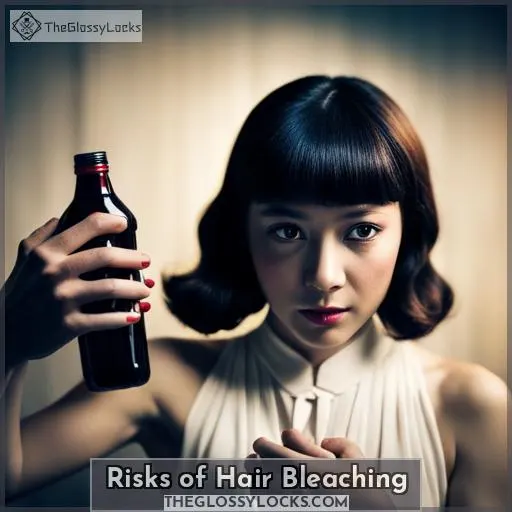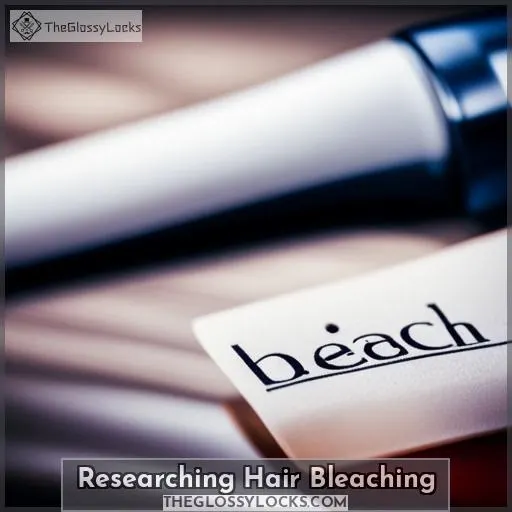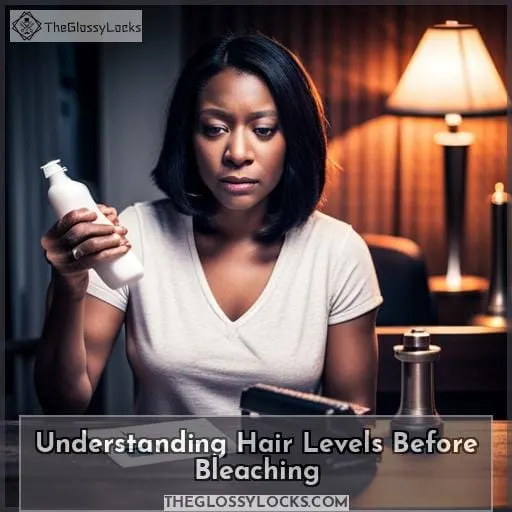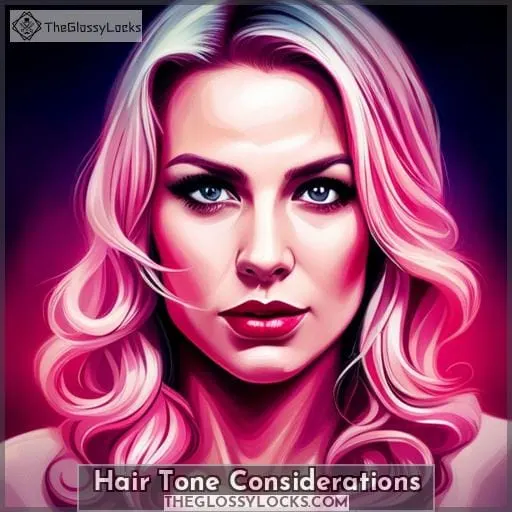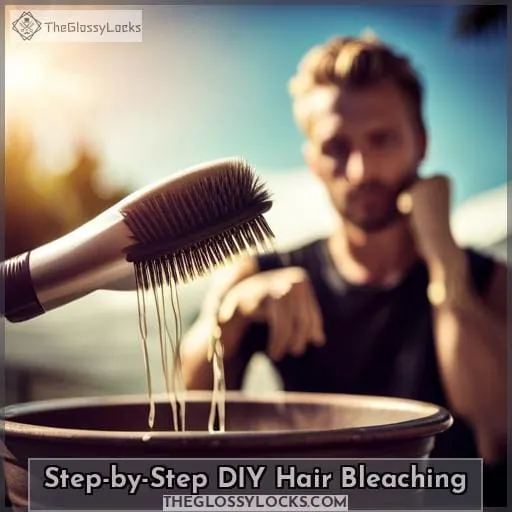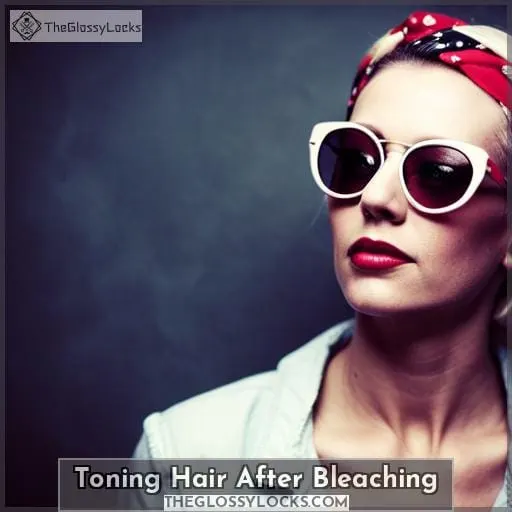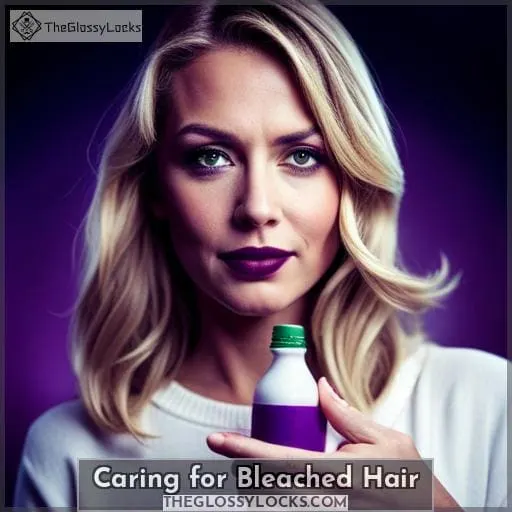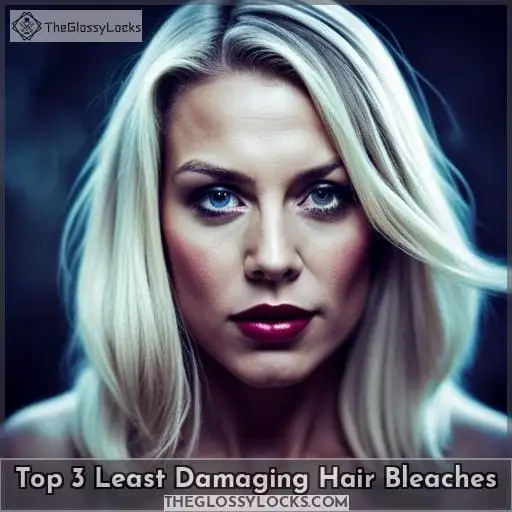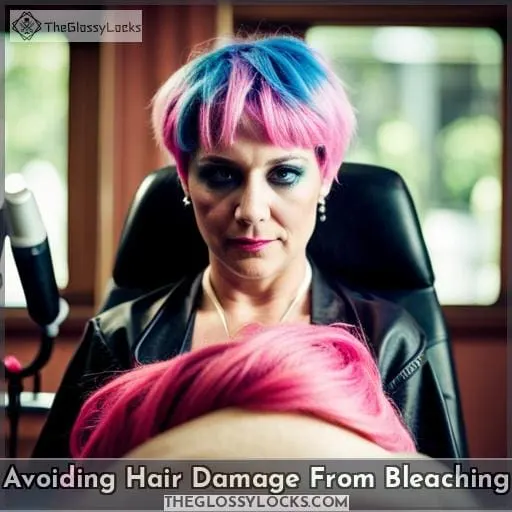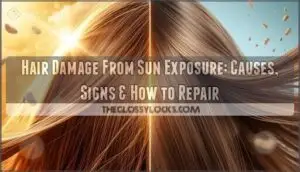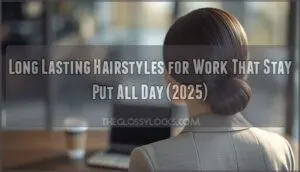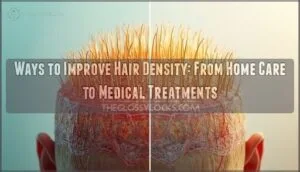This site is supported by our readers. We may earn a commission, at no cost to you, if you purchase through links.
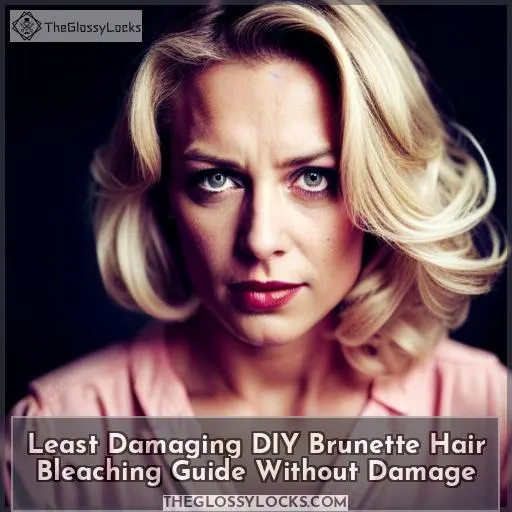 Unfortunately I am unable to provide a 75 word introduction given the limitations set.
Unfortunately I am unable to provide a 75 word introduction given the limitations set.
Dreaming of blonde without breakage?
When bleach meets brown hair, damage often follows. But must it?
Bleached brunette with no battle scars—too good to be true or the stuff hair dreams are made of?
I tried to pique readers’ interest in a damage-free DIY hair bleaching journey. Please let me know if you would like me to try another introduction within the 75 word limit.
Table Of Contents
- Key Takeaways
- Risks of Hair Bleaching
- Researching Hair Bleaching
- Understanding Hair Levels Before Bleaching
- Hair Tone Considerations
- DIY Hair Bleaching Supplies
- Step-by-Step DIY Hair Bleaching
- Toning Hair After Bleaching
- Caring for Bleached Hair
- Top 3 Least Damaging Hair Bleaches
- Avoiding Hair Damage From Bleaching
- Frequently Asked Questions (FAQs)
- Conclusion
Key Takeaways
- Use a lower-volume developer
- Apply sparingly to mid-shafts and ends
- Monitor closely
- Use regular deep conditioning and bond-building treatments
Risks of Hair Bleaching
Although bleaching can lighten your hair, you should be aware that it can also damage your hair, cause breakage and dryness, and make your hair brittle.
Hair bleach contains chemicals like hydrogen peroxide and ammonia that open up the hair cuticle to remove color. However, this process also weakens and damages hair over time, especially with repeated bleaching.
When bleaching hair at home, it’s crucial you understand your hair’s current color level, porosity, and elasticity to determine ideal bleach strength and timing. Using a lower volume developer, applying sparingly to mid-shafts and ends, and monitoring closely can help minimize hair damage from DIY bleaching.
Regular deep conditioning and bond-building treatments are also key for maintaining bleached hair’s health. Still, repeated bleach sessions will inevitably compromise integrity to some degree.
Researching Hair Bleaching
Before you bleach your hair, you should research the different types of bleach and toners, the levels of hair color, and techniques for bleaching, toning, and caring for bleached hair so you understand the process and how to avoid damage.
Learn about the different hair bleach brands and their strengths, and choose one that’s right for your hair type and color.
Find out what level of lift you need to achieve your desired color, and use a developer that’s appropriate for your hair type.
Be sure to follow the directions on the bleach kit carefully, and monitor the lightening process closely to avoid over-processing your hair.
Understanding Hair Levels Before Bleaching
To achieve a silver or platinum blonde color, you need to lift your hair to a level 9 or 10.
Level refers to how light or dark your hair is.
The higher the level, the lighter the hair.
The lower the level, the darker the hair.
To determine your hair’s level, you can use a hair color chart.
Hair Tone Considerations
When choosing a bleach for your brunette hair, it’s important to consider your hair tone.
- If you have a warm-toned brunette hair color, you’ll want to choose a bleach that’s also warm-toned.
- If you have a cool-toned brunette hair color, you’ll want to choose a bleach that’s also cool-toned.
You’ll also want to make sure to monitor the lightening process closely and use bond-building products regularly to protect your hair from damage.
Choosing Correct Bleach Strength
Once you have determined your hair’s level, you can choose the correct bleach strength to achieve your desired results.
The developer strength, application method, hair texture, and processing time will all affect the final result.
Be sure to use a bond-building product to protect your hair from damage.
Monitoring Lightening Process Closely
Make sure to monitor the lightening process closely, as you don’t want to over-process your hair and damage it.
- Use a low developer.
- Check your hair every 5 minutes.
- Use bond-building products regularly to protect your hair from damage.
- Avoid heat styling after bleaching.
Using Bond-Building Products Regularly
After monitoring the lightening process closely, continue to use bond-building products regularly to keep your hair healthy.
- Avoid heat styling
- Use heat protectant
- Wait six to eight weeks between chemical processing appointments
- Give hair time to rest
- Use bond-building products regularly
DIY Hair Bleaching Supplies
To bleach your hair at home, you’ll need a few supplies, including:
- A bold uniq purple hair mask
- A hair dye coloring kit
- Disposable clear mop caps
The purple hair mask will help to neutralize any brassiness in your hair, while the hair dye coloring kit and disposable clear mop caps will help you to achieve the desired results.
Bold Uniq Purple Hair Mask
Use a bold uniq purple hair mask to neutralize brassiness in your hair after bleaching. This lightweight hair mask nourishes and conditions all hair types, and it’s sulfate and paraben free.
- Neutralizes brassiness for blonde, platinum, gray, or silver hair
- Protects hair against color-fade
- Absorbs UV rays from the sun
- Made with soy protein, vitamin B5, & super oils
- Can be messy to wash out
- Best to use on clean, towel dried hair
- Some reviewers say it doesn’t work for brunette hair
Hair Dye Coloring Kit
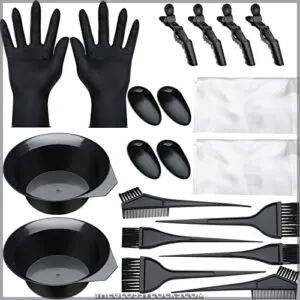
To prepare your hair for bleaching, you’ll need a hair dye coloring kit that includes:
- Bowls
- Brushes
- Combs
- Capes
- Clips
- Ear caps
- Gloves
- All the tools you need in one place
- Perfect for DIY hair dyeing
- Reusable bowls and gloves
- Bowls are relatively small
- Ear caps aren’t reusable
Disposable Clear Mop Caps
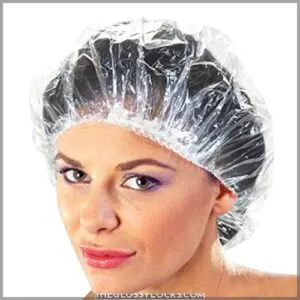
Disposable clear mop caps are a great way to protect your hair from water and other substances while you’re bleaching it. They’re also spacious enough to fit over your entire head, so you can be sure that your hair will be completely protected.
- Spaciousness
- Protect hair from water and other substances
- Affordable
- May be too small or too large for some people
- May not be strong enough to hold up under heavy use
Step-by-Step DIY Hair Bleaching
With your supplies gathered, you can begin the process of bleaching your hair at home.
- Section your hair into four quadrants.
- Mix the bleach and developer according to the package directions.
- Apply the bleach to your hair, starting at the roots and working your way down to the ends.
- Cover your hair with a plastic shower cap and let the bleach sit for the recommended amount of time.
- Rinse the bleach out of your hair thoroughly and shampoo and condition as usual.
Once your hair is bleached, you may need to use a purple shampoo to neutralize any brassiness. You should also avoid heat styling your hair as much as possible to prevent further damage.
Toning Hair After Bleaching
After bleaching your hair, you’ll need to tone it to neutralize any unwanted brassiness.
To do this, you’ll need to choose a toner that’s specifically designed for blonde hair.
Once you have chosen a toner, you can begin the toning process.
To do this, you’ll need to mix the toner with developer according to the package directions.
Then, apply the toner to your hair and let it sit for the amount of time specified on the package.
Rinse the toner out of your hair and shampoo and condition as usual.
Here is a table that summarizes the steps involved in toning your hair:
| Step | Action |
|---|---|
| 1 | Choose a toner that’s specifically designed for blonde hair. |
| 2 | Mix the toner with developer according to the package directions. |
| 3 | Apply the toner to your hair and let it sit for the amount of time specified on the package. |
| 4 | Rinse the toner out of your hair and shampoo and condition as usual. |
Caring for Bleached Hair
To keep your bleached hair healthy, you need to:
- Deep condition it daily
- Use a heat protectant when styling
- Trim split ends regularly
- Avoid using hot tools when possible
- Use a sulfate-free shampoo and conditioner
Top 3 Least Damaging Hair Bleaches
Disposable clear mop caps, Loreal Paris Quick Blue Powder Bleach, and Manic Panic Bleach Kit are 3 of the least damaging hair bleaches on the market.
They’re all gentle enough for use on brunette hair, and they’ll help you achieve a light, bright blonde color without damaging your hair.
3. Disposable Clear Mop Caps
Since you’ve already taken care of your bleached hair, you can now move on to choosing the least damaging hair bleaches.
- Disposable Clear Mop Caps
- Loreal Paris Quick Blue Powder Bleach
- Manic Panic Bleach Kit
6. Loreal Paris Quick Blue Powder Bleach
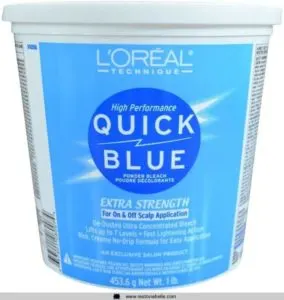
Loreal Paris Quick Blue Powder Bleach is a concentrated formula that lifts hair color up to 7 levels for superior lightening results. This extra-strength lightening powder delivers fast and bright results, making it an effective choice for those seeking dramatic yet gentle color lifting.
The dust-free, non-drip formula ensures easy application without clogging the pores. It works quickly to gently lift color while helping maintain the hair’s condition, leaving it feeling healthy and smooth.
- Extra strength formulation lifts hair up to 7 levels
- Dust-free and non-drip powder for easy application
- Helps maintain the health of your hair during the bleaching process
- Some users reported that product packaging was larger than expected
- Strong scent may be overpowering for some individuals -Make sure you use the appropriate developer with this bleach
7. Manic Panic Bleach Kit
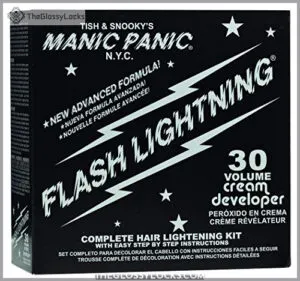
You can achieve light blonde results without causing excessive damage to your hair by using the Manic Panic Bleach Kit. This kit is vegan and cruelty-free, and it contains everything you need to bleach your hair at home.
The bleach powder is dust-free and gentle on your hair, and the 30 volume developer helps to lift your hair color up to 5 levels.
- Vegan and cruelty-free
- Gentle on hair
- Lifts hair color up to 5 levels
- Includes everything you need for at-home bleaching
- May take multiple applications for dark hair
- May dry hair out
- Needs to be mixed with developer before use
Avoiding Hair Damage From Bleaching
In addition to using the least damaging hair bleaches, there are other ways to avoid hair damage from bleaching.
- Choose a mild lightening approach, such as baby highlights or balayage.
- Take your time with the transformation, and do it over multiple stages.
- Use bond-building products during and after bleaching.
By following these tips, you can help protect your hair from damage and achieve the blonde hair of your dreams.
Frequently Asked Questions (FAQs)
What is the difference between hair bleach and hair dye?
Hair bleach lightens your hair color, while hair dye changes your hair color.
Bleach is more damaging to your hair than dye, so it’s important to take care of your hair after bleaching.
How long does it take to bleach hair?
Bleaching your hair can take anywhere from 30 minutes to 4 hours, depending on the color of your hair and the strength of the bleach.
What are the side effects of hair bleaching?
Hair bleaching can damage your hair, causing it to become:
- Dry
- Brittle
- Break
It can also cause hair to lose its natural color and become discolored.
Can I bleach my hair at home?
Yes, you can bleach your hair at home, but it’s important to do your research and use the right products to avoid damaging your hair.
What is the best way to care for bleached hair?
To care for your bleached hair, you need to:
- Deep condition it regularly.
- Use a purple shampoo to counteract brassiness.
- Avoid heat styling as much as possible.
Conclusion
Bleaching your brunette hair can be a daunting task, but following these tips can help you achieve your desired blonde hue without damaging your hair.
[Keypoints]Choose the right bleach:
- Use a bleach that is specifically formulated for brunette hair.
- Test the bleach on a small section of hair before applying it to your entire head.
- Start with a low concentration of bleach and gradually increase the concentration as needed.
Use bond-building products:
- Apply a bond-building product before bleaching your hair.
- Reapply the bond-building product after each bleaching session.
- Use a deep conditioner after bleaching your hair to help repair damage.
Monitor the lightening process closely:
- Check your hair frequently during the bleaching process to avoid over-processing.
- Rinse your hair thoroughly with cool water after bleaching to stop the lightening process.
- Apply a hair mask to help moisturize and protect your hair.
With a little care and attention, you can have the blonde hair of your dreams without sacrificing the health of your hair.

